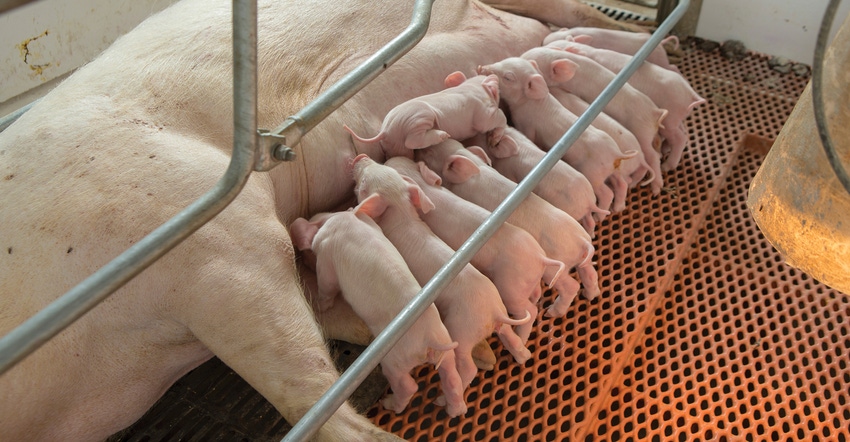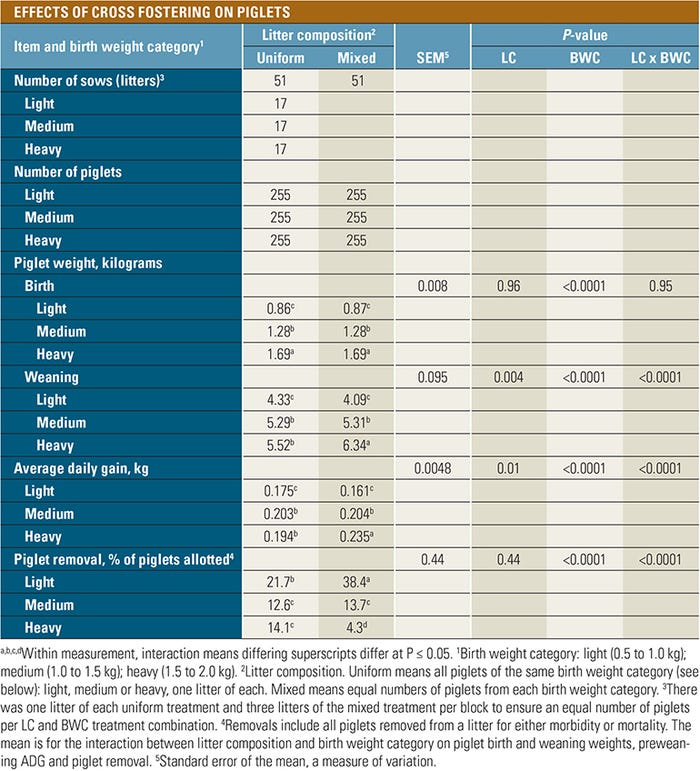Benefits vary by weight of piglets.
January 9, 2020

Cross fostering is a common practice to equalize litter size, and to diminish the effects of competition for the sow's milk as well as piglets' competition for space.
Though a common practice, is cross fostering actually beneficial? There is limited understanding of optimum cross-fostering methods to use to maximize piglet performance.
Researchers at the University of Illinois at Urbana-Champaign, in cooperation with The Maschhoffs LLC, sought to look at the effects that cross fostering of litters had on preweaning mortality.
This study evaluated effects of within-litter birth weight variation after cross fostering on preweaning piglet removals (morbidity and mortality) and average daily gain.
A hierarchical incomplete block design was used (blocking factors day of farrowing, and sow parity and structure) with a 3x2 factorial arrangement of treatments.
The first was birth weight category (BWC): light (under 1.0 kilogram), medium (1.0 to 1.5 kg) or heavy (1.5 to 2.0 kg. The second was litter composition (LC): uniform (piglets of the same BWC) and mixed (equal numbers of piglets from each BWC).
Piglets were weighed 24 hours after birth and allotted to form litters of 15 cross-fostered piglets. The experimental unit was five piglets of the same BWC (three experimental units per litter).
A total of 102 litters were allotted to 17 blocks of six litters (one uniform litter of each BWC and three mixed litters), with 51 replicates (three replicates per block of six litters).
Weaning weights and pig removals were measured. Models included LC, BWC, the interaction and replicate within the block. There were treatment interactions (P < 0.05) for all measures except birth weight.
There was no effect (P > 0.05) of LC on weaning weight or average daily gain for light or medium piglets; heavy piglets had greater (P < 0.05) weaning weight and average daily gain in mixed than in uniform litters.
Pig removals were greater (P < 0.05) for light piglets in mixed than in uniform litters, and for heavy piglets in uniform than in mixed litters. Pig removals for medium piglets were similar (P > 0.05) across LC treatments.
In conclusion, rearing cross-fostered piglets in uniform litters reduced pig removals for light piglets. It increased pig removals and reduced the average daily gain of heavy piglets, with no effect for medium piglets.

Birth weight deciding factor
The optimum strategy to use for cross fostering in the first 24 hours after birth to minimize preweaning mortality is different for light- and heavy-birth-weight piglets. In other words, using a cross-fostering strategy that improves the survival of light piglets will reduce the survival of the heavy piglets, and vice versa.
For piglets that were cross-fostered within the first 24 hours after birth, there were differing levels of preweaning mortality, depending on both piglet birth weight and the variation of piglet weights within a litter.
Cross fostering to create litters of uniform birth weight with only light piglets (less than a 2.2-pound birth weight) reduced preweaning mortality levels, compared to rearing light piglets in litters with mixed birth weights — i.e., equal numbers of light, medium (2.2 to 3.3 pounds) and heavy (3.3 to 4.4 pounds) piglets.
For piglets with heavy birth weights, the opposite was the case; preweaning mortality was lower in mixed-birth-weight litters than in uniform litters of only heavy piglets. Prewean mortality levels for medium-birth-weight piglets were similar whether they were reared in litters with uniform or mixed birth weights.
The costs associated with the various approaches to cross fostering on the basis of piglet birth weight that were evaluated in this research are likely to be similar.
The potential cost benefit of these approaches to cross fostering on the basis of birth weight will, therefore, depend on the number and weight of the piglets that survive to weaning.
Producers should base their conclusions for this research on the variation in piglet weights that they observe in their population of pigs.
Researchers: Katherine D. Vande Pol, Rafael Ovidio Bautista Rivas, Heath Harper and Mike Ellis, University of Illinois, Urbana-Champaign; and Caleb M. Shull and Katie Brown, The Maschhoffs LLC, Carlyle, Ill. For more information, contact Vande Pol.
You May Also Like



